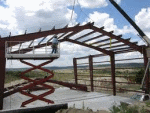
Some components of a steel building are better known than others. As expected, people are mostly familiar with those that they can see, such as walls and roofs. However, they do not know about those that may not be as apparent but are equally important, such as purlins and side rails. These may be called secondary steelwork, but they play a crucial role in building steel structures. Without these, there will be no steel frame and in turn, no steel structure to speak of. It is about time people learn more about them and their function in steel buildings construction.
Introducing purlins and side rails
Purlins and side rails are considered as secondary members, but they serve a very important purpose: to carry loads from the cladding to the main steel frame. Loads transferred by these secondary members include wind loads and even the cladding's own weight; in the case of roofs, the loads include imposed loads from maintenance and snow. In many portal-framed industrial steel buildings, specifically those with low pitch roofs, it is a system of purlins and side rails that support the cladding: the purlins support the cladding sheets or panels between the rafters while the side rails support those found between the columns.
Purlins and side rails, which are usually manufactured from light gauge galvanized steel (of the cold formed variety), are an essential part of the system that supports the cladding, that which includes fasteners and fittings. These can also be used to give restraint to rafters and columns, as well as to shift horizontal loads to a bracing system.
These secondary members come in a wide selection of shapes and sizes. Common section shapes of purlin include zed, ultrazed, zeta and sigma. Section depth usually ranges from 120 mm to 340 mm, while the profile thickness is typically between 1.2 mm and 3.2 mm.
Other components used with purlins and side rails
There are some components that are important in the use of purlins and side rails. These allow the secondary members to fulfil their function. One of these are anti-sag rods—these are basically rods (or angles) that are attached between purlins, typically situated either at third points along the purlin or at the middle of the span. Anti-sag rods are necessary to keep purlins aligned and to offer restraint to them during construction (before cladding is installed) as well as against collapsing due to wind uplift. These also offer added support to the downward slope aspect of applied loads. Whether or not anti-sag rods are necessary is determined by several factors, such as the span of the purlins, spacing between purlins and magnitude of applied loads.
Another component used with purlins are cleats. The cleats are those that attach the purlins to the rafters. These are welded to the rafter in the manufacturing shop prior to delivery. Because cleats come from the same manufacturer that made the purlins, both components fit each other perfectly (since they are designed to be so). Cleats, particularly the bolted variety, are becoming a preferred choice because they help reduce transportation costs (rafters can be stacked and are therefore compact in transit) and allow easier cladding installation (cleats let the alignment of purlins to be adjusted on site).
As for side rails, they also have supports. Side rails used for cladding for walls need vertical restraints, those that function the same way anti-sag rods do for roofs. The restraints make sure the walls will not collapse due to wind loads as well as prevent the side rails from dipping because of the weight of the cladding and the system that supports it. Vertical restraints come in the form of steel rods or bars, as well as angles, tubes or channels. These are usually made with light gauge steel.
Layout options for purlins and side rails
There are a number of purlin layouts that can be used for different construction scenarios. Manufacturers of purlins and side rails often provide guidance on what kind of layout to use for a given situation. The layouts are influenced by several factors, including length (there is a maximum measurement limitation set to allow easier transport and access) as well the capacity to offer semi-continuity (with the use of overlaps or sleeves).
These are some of the purlin and side rail layouts: sleeved system, butted system, and overlapping system for single-span lengths; non-sleeved system and sleeved system for double-span lengths.
It is important to note that the purlin manufacturer should be consulted before any specific layout is used and finalized. Only manufacturers can provide information that will determine whether or not one layout is ideal for a specific scenario.
The author of the article above is Jessie Moore. She has written many articles regarding steel frame buildings for Steel Buildings Design a Scottish based company who specialise in steel framed buildings. Check out company website
